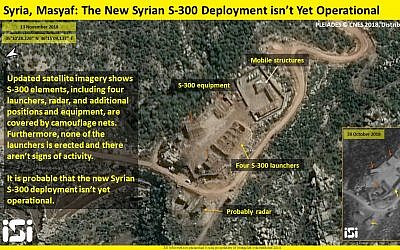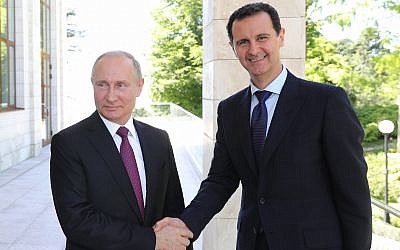John Hilly
Ylipäällikkö
Syyrian S-300 ilmatorjuntajärjestelmä tulossa toimintavalmiuteen.
Images show S-300 air defense batteries in Syria likely turning operational
Israel’s ImageSat International says 3 of 4 launchers from powerful Russian anti-aircraft system appear to be raised, possibly signifying heightened alert level

Satellite photos released by ImageSat International appear to show three out of four missile launchers of the S-300 air defense system in the raised position in Masyaf on February 5, 2019. (ImageSat International)
An Israeli satellite imaging company on Tuesday said it had for the first time detected that a suspected Syrian S-300 air defense system appeared on track to become operational, signaling a possible threat to Israel’s air campaign against Iran in the country.
However, the ImageSat International firm added that there remained significant questions about the anti-aircraft battery’s condition.
https://www.timesofisrael.com/image...ign=daily-edition-2019-02-06&utm_medium=email
Images show S-300 air defense batteries in Syria likely turning operational
Israel’s ImageSat International says 3 of 4 launchers from powerful Russian anti-aircraft system appear to be raised, possibly signifying heightened alert level

Satellite photos released by ImageSat International appear to show three out of four missile launchers of the S-300 air defense system in the raised position in Masyaf on February 5, 2019. (ImageSat International)
An Israeli satellite imaging company on Tuesday said it had for the first time detected that a suspected Syrian S-300 air defense system appeared on track to become operational, signaling a possible threat to Israel’s air campaign against Iran in the country.
However, the ImageSat International firm added that there remained significant questions about the anti-aircraft battery’s condition.
Russia has said the S-300 platform it was giving Syria following September’s incident would “cool off hot heads” in the region.
Since the system was delivered in October, Russia has been training Syrian forces to operate the powerful air defense platform, reportedly at a base near Masyaf in northwestern Syria.
On Tuesday, the firm revealed that three of the four launchers of the S-300 system at the Masyaf base were raised, as evident by the shadows they cast on the ground next to them. This was the first time that the launchers were photographed in a raised position, though not necessarily the first time they had been put in position, the company said.

Satellite photos released by ImageSat International on November 14, 2018 appear to show S-300 systems in the northwestern Syrian city of Masyaf are not yet operational. (ImageSat International)
In November, the firm also released photographs of the battery, showing that it did not appear to be operational at that time.
For years, Israel has been waging a campaign against Damascus’s ally, Iran, which Jerusalem accuses of attempting to establish a permanent military presence in Syria to threaten the Jewish state.
This once quiet fight has become increasingly public in recent months, with each side issuing threats against the other.
“Due [to] the current regional tension… it is possible that the mentioned activity indicates [an] increase of the operational level and alertness,” ImageSat said.
However, the company noted that the precise meaning of the raised launchers is not clear from the images alone.
Notably, one of the launchers remains down and covered by a camouflage net, while the others are erect, which ImageSat said was a “rare” situation that “raises question marks about the operational level of the whole battery.”
Syria’s acquisition and eventual operation of the S-300 system marks a substantial improvement in its air defense capabilities. However, Israel has long been rumored to be capable of maneuvering around the system. Israeli officials have also warned that the IDF is prepared to destroy the powerful anti-aircraft system if it fires upon Israeli jets, despite the fact that this would likely be denounced by Russia, the most influential superpower in the region.

Russian President Vladimir Putin shakes hands with Syrian President Bashar Assad during their meeting in Russia, May 17, 2018. (Mikhail Klimentyev, Sputnik, Kremlin Pool Photo via AP)
In addition to four interceptor missile launchers, Moscow also provided Syria with new radars, targeting systems and command centers.
The Syrian military last year said it believed the S-300 air defense systems would largely stop Israel from successfully conducting strikes against targets in the country.
https://www.timesofisrael.com/image...ign=daily-edition-2019-02-06&utm_medium=email

